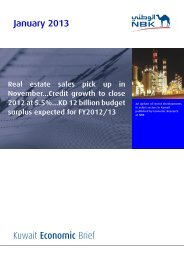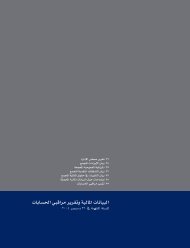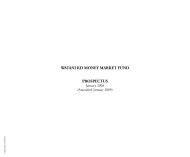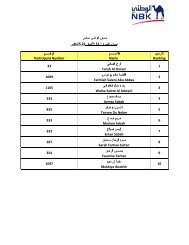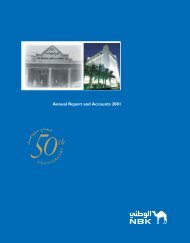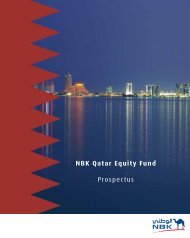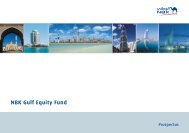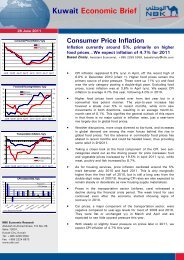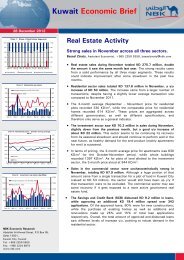Annual Report and Accounts 2004 - National Bank of Kuwait
Annual Report and Accounts 2004 - National Bank of Kuwait
Annual Report and Accounts 2004 - National Bank of Kuwait
- No tags were found...
You also want an ePaper? Increase the reach of your titles
YUMPU automatically turns print PDFs into web optimized ePapers that Google loves.
Credit growth moderated somewhat during <strong>2004</strong>to 16% from last year’s 23%, with total outst<strong>and</strong>ingdomestic facilities reaching KD 9.81 billion (US$33.3 billion). Personal facilities continued todominate growth in credit, having risen by 17%,while lending to the trade sector was only slightlybehind in volume, though it was the fastestgrowing at a rate <strong>of</strong> 31%. Loans to the real estatesector continued to see healthy growth <strong>of</strong> 12%.Growth in salary-based loans to consumers slowednotably from a fast pace in recent years, followinga CBK directive scaling back maturities for newloans <strong>and</strong> effectively lowering the amount that aborrower can borrow on a given salary. AnotherCBK directive limiting the use <strong>of</strong> back-to-backinterbank loans to increase their consumer lendingceiling also contributed to reducing salary-relatedcredit during the second half <strong>of</strong> the year, as did therecent rise in interest rates. Still, such loansaccounted for 10% <strong>of</strong> the growth in domestic creditduring the first nine months <strong>of</strong> the year, <strong>and</strong>represented 25% <strong>of</strong> total outst<strong>and</strong>ing facilities.The redemption <strong>of</strong> outst<strong>and</strong>ing Debt PurchaseBonds (DPBs) continued with the balance held bybanks falling by KD 215 million. <strong>Bank</strong>s continuedto hold KD 604 million in DPBs on their books atthe end <strong>of</strong> <strong>2004</strong>, representing 3.2% <strong>of</strong> totalbank assets.Liquid assets <strong>of</strong> banks, comprising cash, depositswith the CBK <strong>and</strong> public debt instruments, fell by9.1%. The decline was largely the result <strong>of</strong> a continueddrop in time deposits with the CBK. At theend <strong>of</strong> <strong>2004</strong>, liquid assets as defined above represented13.2% <strong>of</strong> total bank assets, versus 14.8%at the end <strong>of</strong> 2003 <strong>and</strong> 21% at the end <strong>of</strong> 2002.Following a period <strong>of</strong> declining <strong>and</strong> low interest rates lasting some four years,the CBK began lifting its benchmark discount rate starting on July 1st. By theend <strong>of</strong> <strong>2004</strong> the CBK had hiked its discount rate five times, by a total <strong>of</strong> one<strong>and</strong> a half percentage points to 4.75%. The CBK’s actions mostly followedsimilar moves by the US Fed. The rise in the discount rate has been followedby increases in deposit rates. This is reflected in the rise in the semi-annualinterest rate paid by the government to local banks on its outst<strong>and</strong>ing DPBs,where this rate has normally matched the average cost <strong>of</strong> local currencydeposits. The rate was set at 1.88% for the December payment compared to1.76% in June. Lending rates also moved higher with the discount rate, as mostloans in <strong>Kuwait</strong> are extended on a variable rate basis.Interest rate policy in <strong>Kuwait</strong> is dictated by an exchange rate regime thatpegs the dinar to the US dollar within a narrow b<strong>and</strong>. However, theexchange rate remained fixed throughout <strong>2004</strong> at KD 0.2947 per dollar. Thedepreciation in the dollar, <strong>and</strong> thus in the <strong>Kuwait</strong>i dinar, relative to majorcurrencies helped raise inflation in <strong>2004</strong>, though it remains relatively low.The November consumer price index was 1.8% higher from a year agoversus an increase <strong>of</strong> 1.2% in 2003.<strong>Bank</strong>ing <strong>and</strong> financial sectorA strong domestic economy, higher lending volumes <strong>and</strong> rising interest ratesprovided a solid boost to the pr<strong>of</strong>itability <strong>of</strong> <strong>Kuwait</strong>i banks. Consolidated pr<strong>of</strong>its<strong>of</strong> the country’s nine banks were up 23% during the first nine months <strong>of</strong> <strong>2004</strong>.While earnings growth came largely from net interest income, fees <strong>and</strong>commissions also saw healthy growth.<strong>Bank</strong>s have been consistently the most pr<strong>of</strong>itable sector among locally listedcompanies, contributing 28% <strong>of</strong> total reported earnings in <strong>2004</strong>. As a whole,listed companies saw earnings growth slow down to 12% during the firstnine months <strong>of</strong> <strong>2004</strong> compared to a 92% rise in 2003. Still, the rise inearnings, coupled with improved business prospects, kept investors bullishon local stocks.The <strong>Kuwait</strong> Stock Exchange (KSE), among the best-performing markets in 2003,sustained its rally in <strong>2004</strong> albeit at a more moderate pace. The general marketindex rose by 34% versus 102% in 2003, while the value weighted index roseby a smaller 15%. Market capitalisation rose by 23% to KD 21.5 billion (US$73 billion), or roughly 140% <strong>of</strong> our GDP forecast for the year. Of the KD 3.7billion increase in market capitalisation, KD 1.4 billion came from the listing<strong>of</strong> 18 new companies. Trading activity was down slightly from last year, thoughit remained relatively high. The market price-to-earnings (P/E) ratio declinedto 13.5 from 14.7 at end-2003, using 12-month trailing earnings.29






